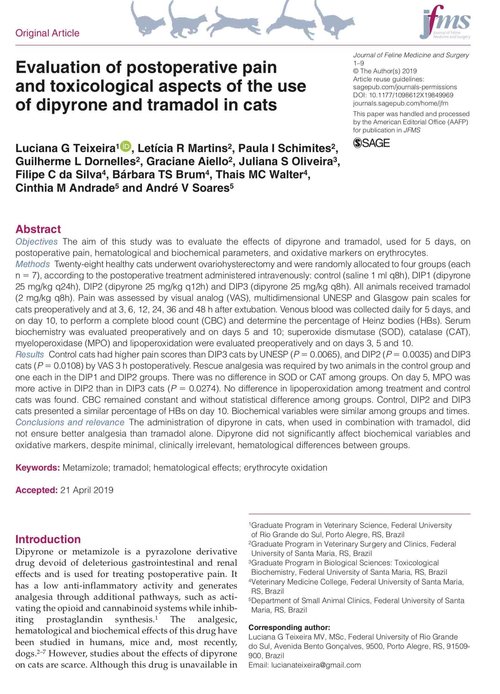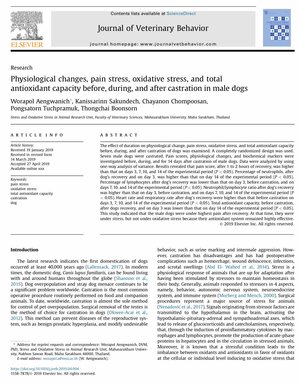AINS et IRC chat – Tramadol dipyrone et DPO chat – Spiruline
DOULEUR CHEZ LES CHIENS ET CHATS
1/ Long-term use of non-steroidal anti-inflammatory drugs in cats with chronic kidney disease: from controversy to optimism.
Monteiro B, Steagall PVM, Lascelles BDX, Robertson S, Murrell JC, Kronen PW, Wright B, Yamashita K J Small Anim Pract., 2019 May 12.
Résumé :
This is the first of a series of capsule reviews published by the World Small Animal Veterinary Association – Global Pain Council (WSAVA-GPC). Each of these short articles provides a brisk assessment of the scientific evidence in specific aspects of pain management, including analgesic techniques, recommendations and controversies surrounding their use. In this first capsule review, the scientific evidence available on the long-term use of non-steroidal anti-inflammatory drugs in cats with concomitant chronic pain and chronic kidney disease is discussed.
In conclusion, based on current evidence, the WSAVA-GPC supports the long-term administration of the lowest effective doses of meloxicam and robenacoxib in cats with concomitant chronic pain and CKD as part of a multimodal approach that includes non-pharmacological therapies, unless contraindicated. Other NSAIDs should not be used in this population of cats unless safety data for that purpose become available. Label rec- ommendations for long-term NSAID administration might vary in different countries. The decision to treat these cats must be based on a thorough discussion with the owners as not all cats are satisfactory candidates for long-term NSAID therapy. Cats must have stable CKD, and maintenance of proper hydration is para- mount. Adjuvant analgesics and non-pharmacological therapies should also be considered in cats with OA or any other chronic painful condition.
PDF : https://www.capdouleur.fr/app/uploads/2020/06/monteiro2019.pdf
2/ Evaluation of postoperative pain and toxicological aspects of the use of dipyrone and tramadol in cats
Luciana G Teixeira, Letícia R Martins, Paula I Schimites, Guilherme L Dornelles, Graciane Aiello, Juliana S Oliveira, Filipe C da Silva, Bárbara TS Brum, Thais MC Walter, Cinthia M Andrade, André V Soares J. Fel. Med. Surg., First Published May 21, 2019
Résumé :
The aim of this study was to evaluate the effects of dipyrone and tramadol, used for 5 days, on postoperative pain, hematological and biochemical parameters, and oxidative markers on erythrocytes.
Methods : Twenty-eight healthy cats underwent ovariohysterectomy and were randomly allocated to four groups (each n = 7), according to the postoperative treatment administered intravenously: control (saline 1 ml q8h), DIP1 (dipyrone 25 mg/kg q24h), DIP2 (dipyrone 25 mg/kg q12h) and DIP3 (dipyrone 25 mg/kg q8h). All animals received tramadol (2 mg/kg q8h). Pain was assessed by visual analog (VAS), multidimensional UNESP and Glasgow pain scales for cats preoperatively and at 3, 6, 12, 24, 36 and 48 h after extubation. Venous blood was collected daily for 5 days, and on day 10, to perform a complete blood count (CBC) and determine the percentage of Heinz bodies (HBs). Serum biochemistry was evaluated preoperatively and on days 5 and 10; superoxide dismutase (SOD), catalase (CAT), myeloperoxidase (MPO) and lipoperoxidation were evaluated preoperatively and on days 3, 5 and 10.
Results : Control cats had higher pain scores than DIP3 cats by UNESP (P = 0.0065), and DIP2 (P= 0.0035) and DIP3 cats (P = 0.0108) by VAS 3 h postoperatively. Rescue analgesia was required by two animals in the control group and one each in the DIP1 and DIP2 groups. There was no difference in SOD or CAT among groups. On day 5, MPO was more active in DIP2 than in DIP3 cats (P = 0.0274). No difference in lipoperoxidation among treatment and control cats was found. CBC remained constant and without statistical difference among groups. Control, DIP2 and DIP3 cats presented a similar percentage of HBs on day 10. Biochemical variables were similar among groups and times.
Conclusions and relevance : The administration of dipyrone in cats, when used in combination with tramadol, did not ensure better analgesia than tramadol alone. Dipyrone did not significantly affect biochemical variables and oxidative markers, despite minimal, clinically irrelevant, hematological differences between groups.

3/ Spirulina consumption effectively reduces anti-inflammatory and pain related infectious diseases
Gasem Mohammad Abu-Taweel, Al-Mutary Mohsen G, Paulrayer Antonisamy, Selvaraj Arokiyaraj, Young Ock Kim J. Infect. Public Heamth, In Press, Corrected Proof, Available online 22 May 2019
Résumé :
Inflammation and pain triggers several pathological illnesses. Synthetic drugs used for the controlling of inflammatory conditions convey significant toxic effects. Global scientific community continually attempt to improve effective, economic and harmless naturally derived remedies against inflammation and pain. The present study aimed to quantify the phytochemical constituents of the freshly cultivated Spirulina and targeted to examining the anti-inflammatory and analgesic activity of Spirulina extract (SE) derived from Arthrospira platensis. Methods: The anti-inflammatory effect of SE was evaluated in animal models including carrageenan-induced rat hind paw oedema, and cotton pellet-induced granuloma formation. Analgesic effects of SE were evaluated by acetic acid induced writhing response and hot plate test. Results: Phytochemical quantification guided to identify seven carbohydrates, thirteen amino acids, eleven fatty acids and polyphenolic compounds respectively. The results indicated that SE significantly attenuated carrageenan-induced hind paw oedema, and cotton pellet-induced granuloma. Preliminary molecular mechanistic studies established that SE decreased the productions of TNF-α, IL-1β, IL-6, PGE2 and NO, and suppressed the activities of COX-2 and iNOS. Conclusion: These results provide a strong scientific foundation for the anti-inflammatory and analgesic activities of SE against different studies in animal models.





